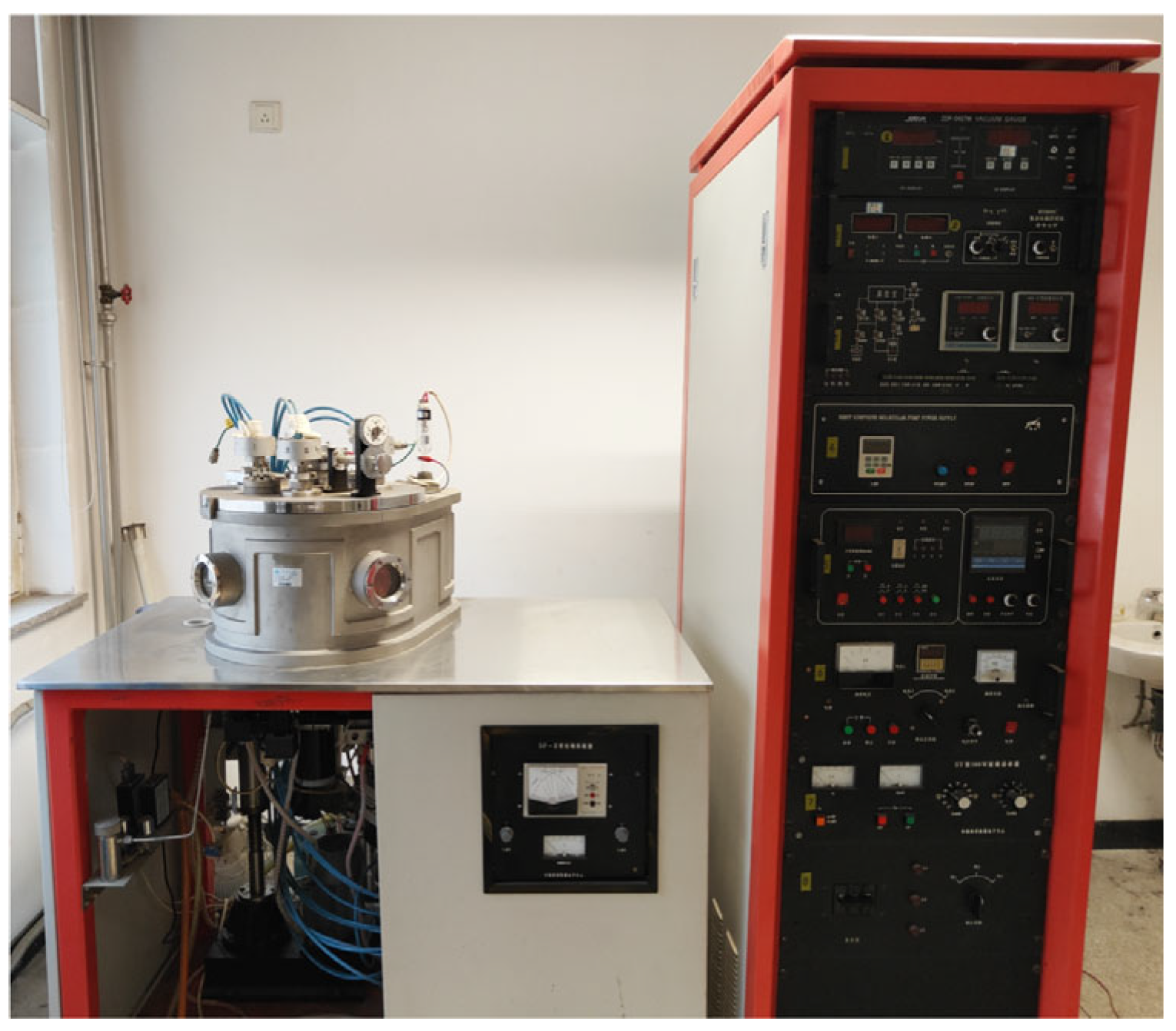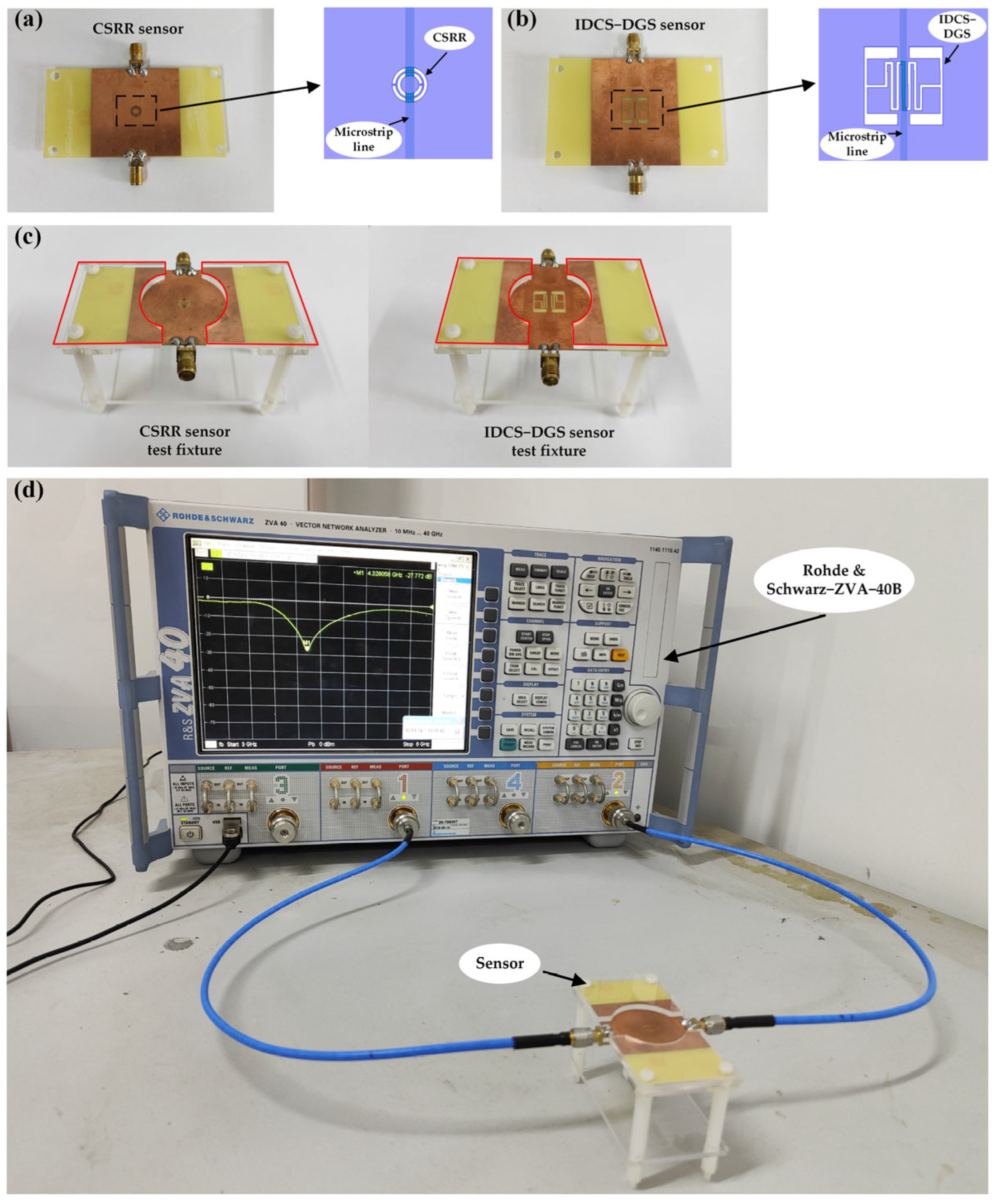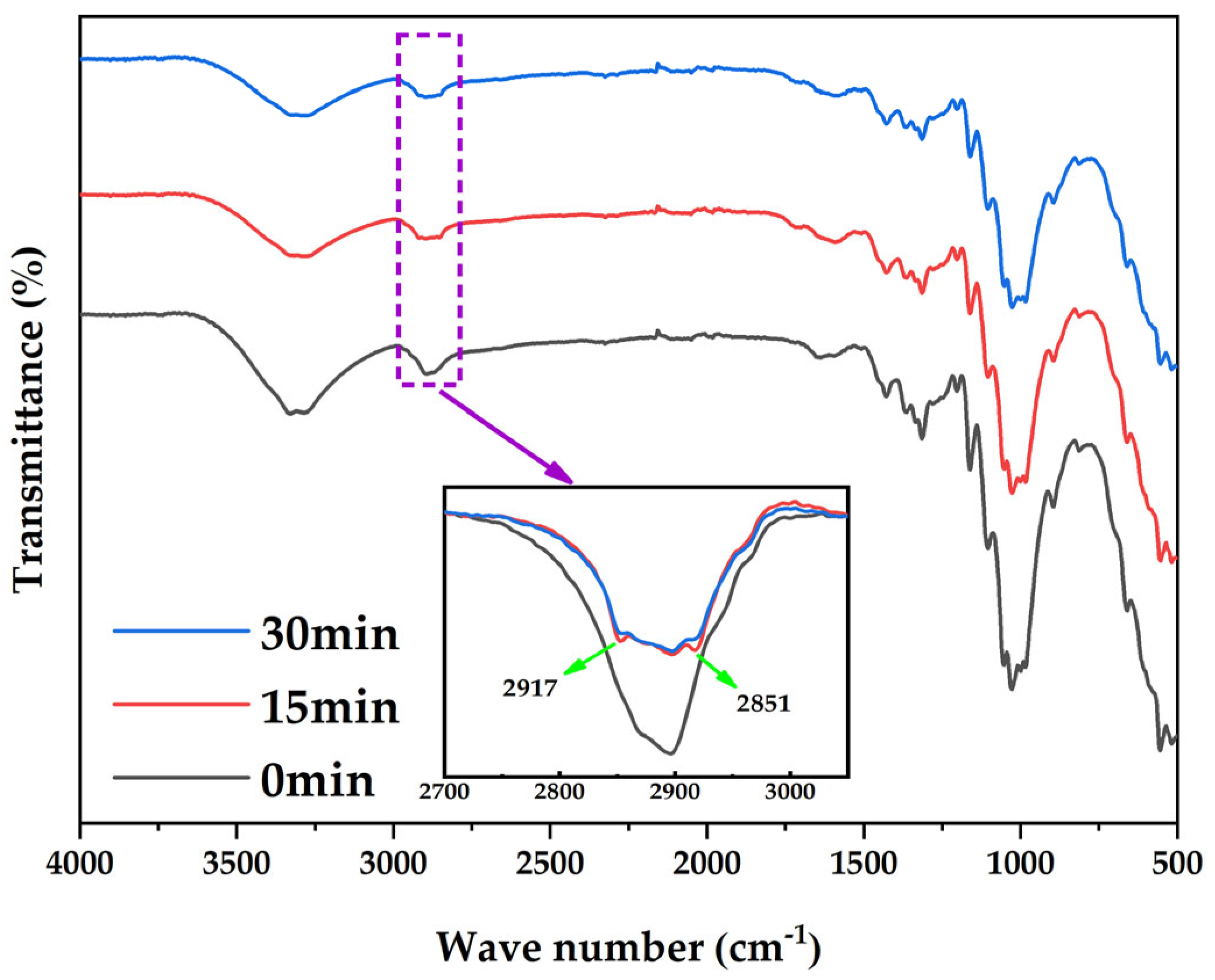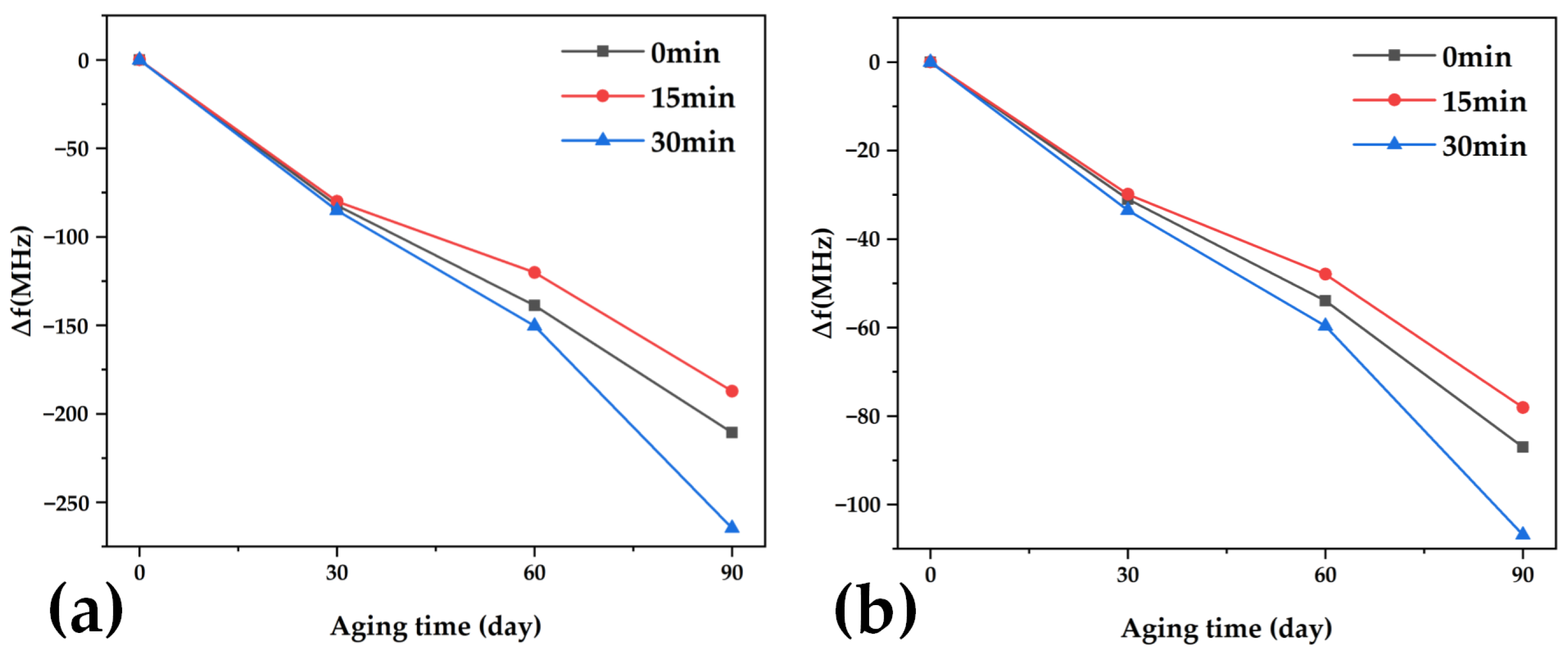Aging Characterization of Modified Insulating Paper Based on the Transmission Characteristics of Microstrip Resonant Sensors
Abstract
:1. Introduction
2. Methods
2.1. Preparation of MgO-Particle-Modified Insulating Paper by Magnetron Sputtering
2.2. Oil/Paper Insulation Thermal Aging Experiment
2.3. Physical and Chemical Properties Analysis
2.4. Microstrip Resonant Sensor Test System
3. Results and Discussion
3.1. Characterization of Modified Insulating Paper after Magnetron Sputtering
3.2. Aging Degree Test of Modified Insulating Paper Based on Microstrip Resonance Sensor
4. Conclusions
- The sputtered MgO particles adhere to the surface of the insulating paper, introduce the interface interval, and make the dielectric constant of the modified insulating paper decrease. The reduction of polar hydroxyl group will also reduce the dielectric constant of the modified insulating paper. However, the dielectric constant of nanometer MgO particles is high, and the dielectric constant of modified insulating paper will increase after a long sputtering time. In addition, excessive sputtering will destroy the fiber molecular structure of the modified insulating paper and produce polar substances, resulting in an increase in its dielectric constant. The interaction between the MgO particles and the insulating paper fibers restricts the movement of carriers and increases the AC breakdown strength. However, excessive sputtering leads to the aggregation of MgO particles into blocks, and the MgO particles at the aggregation are apt to cause charge accumulation, which results in a reduction of the AC breakdown strength. In addition, excessive sputtering will destroy the fiber molecular structure of the modified insulating paper, resulting in an increase in the number of carriers and carrier mobility, which will similarly lead to a decrease in the AC breakdown strength.
- From the test results of FESEM, polymerization degree, dielectric constant and AC breakdown strength of the modified insulating paper at different heat aging stages, the performance of the modified insulating paper with sputtering for 15 min is better. In the modified insulating paper sputtered for 15 min, Mg-O-C bond was formed, which improved the heat aging property of the modified insulating paper. Moreover, MgO particles have good thermal conductivity, which also improves the thermal aging resistance of the modified insulating paper. When the sputtering time is extended to 30 min, the fiber structure is broken due to excessive sputtering, and the degree of polymerization is significantly reduced, so its thermal aging resistance is worse than that of ordinary insulating paper.
- The Δf of the modified insulating paper detected by the CSRR and IDCS-DGS sensors in this paper shifts to the negative direction after a long time of aging. The absolute value of Δf increases gradually with the increase of the degree of aging, which is a good indication of the sample in different aging stages. At the same time, the change of polymerization degree, dielectric constant and AC breakdown strength of the modified insulating paper after aging also proves the feasibility of the new method.
- Although the insulating paper modified by MgO sputtering proposed in this paper is still in the stage of experimental theoretical research, the results provide new ideas for extending the service life of transformer insulating paper and thus reducing the failure rate of transformers caused by insulation deterioration; In addition, the aging characterization method of the modified insulating paper based on the microstrip resonant sensor proposed in this paper can be used to characterize the aging degree of insulating paper flexibly and quickly to a certain extent. Although the research is in the preliminary stage, it still lays a research foundation for the rapid detection of the aging state of transformer insulating paper. Therefore, the content studied in this paper has potential application value to the safe and stable operation of transformers.
Author Contributions
Funding
Data Availability Statement
Conflicts of Interest
References
- Pérez-García, J.; Moral-Carcedo, J. Why Electricity Demand Is Highly Income-Elastic in Spain: A Cross-Country Comparison Based on an Index-Decomposition Analysis. Energies 2017, 10, 347. [Google Scholar] [CrossRef]
- Iftikhar, H.; Turpo-Chaparro, J.E.; Canas Rodrigues, P.; López-Gonzales, J.L. Day-Ahead Electricity Demand Forecasting Using a Novel Decomposition Combination Method. Energies 2023, 16, 6675. [Google Scholar] [CrossRef]
- Van-Hein Sackey, C.; Levin, T.; Nock, D. Latent Demand for Electricity in Sub-Saharan Africa: A Review. Environ. Res. Infrastruct. Sustain. 2022, 2, 022002. [Google Scholar] [CrossRef]
- Manusov, V.Z.; Alexandrov, N.V.; Lukutin, B.V. Impact of Superconducting Transformers on Electric Power System Stability. In Proceedings of the 2013 13th International Conference on Environment and Electrical Engineering (EEEIC), Wroclaw, Poland, 1–3 November 2013; IEEE: Wroclaw, Poland, 2013; pp. 18–21. [Google Scholar] [CrossRef]
- Żurek, S.; Przygrodzki, M. The Use of a Regulating Transformer for Shaping Power Flow in the Power System. Energies 2023, 16, 1548. [Google Scholar] [CrossRef]
- Ali, R.; Khosa, I.; Armghan, A.; Arshad, J.; Rabbani, S.; Alsharabi, N.; Hamam, H. Financial Hazard Prediction Due to Power Outages Associated with Severe Weather-Related Natural Disaster Categories. Energies 2022, 15, 9292. [Google Scholar] [CrossRef]
- Liu, J.; Fan, X.; Zhang, Y.; Zheng, H.; Yao, H.; Zhang, C.; Zhang, Y.; Li, D. A Novel Universal Approach for Temperature Correction on Frequency Domain Spectroscopy Curve of Transformer Polymer Insulation. Polymers 2019, 11, 1126. [Google Scholar] [CrossRef] [PubMed]
- Hao, J.; Feng, D.; Liao, R.; Yang, L.; Lin, Y. Effect of Temperature on the Production and Diffusion Behaviour of Furfural in Oil–Paper Insulation Systems. IET Gener. Transm. Distrib. 2018, 12, 3124–3129. [Google Scholar] [CrossRef]
- Pradhan, M.K.; Ramu, T.S. Diagnostic Testing of Oil-Impregnated Paper Insulation in Prorated Power Transformers under Accelerated Stress. In Proceedings of the Conference Record of the 2004 IEEE International Symposium on Electrical Insulation, Indianapolis, IN, USA, 19–22 September 2004; IEEE: Indianapolis, IN, USA, 2004; pp. 66–69. [Google Scholar] [CrossRef]
- Liu, J.; Zhang, H.; Fan, X.; Zhang, Y.; Zhang, C. Aging Evaluation for Transformer Oil-Immersed Cellulose Insulation by Using Frequency Dependent Dielectric Modulus Technique. Cellulose 2021, 28, 2387–2401. [Google Scholar] [CrossRef]
- Ren, S.; Wu, J.; Wu, H.; Hao, D.; Wu, Y.; Gao, L.; Lv, Z.; Wu, K. Effect of the Aging Status on Ionization of Oil Immersed Paper. In Proceedings of the 2021 IEEE Conference on Electrical Insulation and Dielectric Phenomena (CEIDP), Vancouver, BC, Canada, 17–20 October 2021; IEEE: Vancouver, BC, Canada, 2021; pp. 466–469. [Google Scholar] [CrossRef]
- Wang, W.; Yang, K.; Yue, C.; Chen, S.; He, D. Study on Aging Characteristics of Oil-Immersed Paper and Polymer Material Based on Dielectric Loss. In Proceedings of the 2012 Annual Report Conference on Electrical Insulation and Dielectric Phenomena, Montreal, QC, Canada, 14–17 October 2012; IEEE: Montreal, QC, Canada, 2012; pp. 882–885. [Google Scholar] [CrossRef]
- Abu-Siada, A.; Hmood, S. A New Fuzzy Logic Approach to Identify Power Transformer Criticality Using Dissolved Gas-in-Oil Analysis. Int. J. Electr. Power Energy Syst. 2015, 67, 401–408. [Google Scholar] [CrossRef]
- Li, C.; Yang, L.; Wang, Z.; Tang, C. Polysilsesquioxane-Modified Cellulose Insulating Paper with Improved Mechanical Properties, Dielectric Properties and Aging Resistance. Cellulose 2023, 30, 5935–5947. [Google Scholar] [CrossRef]
- Nikjoo, R.; Taylor, N.; Edin, H.; Hollertz, R.; Wahlander, M.; Wagberg, L.; Malmstrom, E. Comparison of Oil-Impregnated Papers with SiO2 and ZnO Nanoparticles or High Lignin Content, for the Effect of Superimposed Impulse Voltage on AC Surface PD. IEEE Trans. Dielect. Electr. Insul. 2017, 24, 1726–1734. [Google Scholar] [CrossRef]
- Mo, Y.; Liao, R.; Yang, L.; Yuan, Y. Effect of Nanofibrillated Cellulose Doping on Properties of Oil Immersed Insulating Paper during Thermal Aging. In Proceedings of the 2019 IEEE Electrical Insulation Conference (EIC), Calgary, AB, Canada, 16–19 June 2019; IEEE: Calgary, AB, Canada, 2019; pp. 372–375. [Google Scholar] [CrossRef]
- Gao, F.; Xiang, M.; Liao, R.; Xu, Z.; Wang, J. The Experimental Investigation on Space Charge Distribution of Cellulose Insulation Paper Modified with Alumina Nanoparticles. In Proceedings of the 2016 International Conference on Condition Monitoring and Diagnosis (CMD), Xi’an, China, 25–28 September 2016; IEEE: Xi’an, China, 2016; pp. 757–760. [Google Scholar] [CrossRef]
- Du, B.; Jiang, J.; Li, J.; Zhu, W. Effects of ZnO Magnetron Sputtering on Surface Charge and Flashover Voltage of Oil-impregnated Paper. High Volt. 2019, 4, 308–315. [Google Scholar] [CrossRef]
- Jin, L.; Kim, D.; Abu-Siada, A.; Kumar, S. Oil-Immersed Power Transformer Condition Monitoring Methodologies: A Review. Energies 2022, 15, 3379. [Google Scholar] [CrossRef]
- Cheng, L.; Yu, T. Dissolved Gas Analysis Principle-Based Intelligent Approaches to Fault Diagnosis and Decision Making for Large Oil-Immersed Power Transformers: A Survey. Energies 2018, 11, 913. [Google Scholar] [CrossRef]
- Ding, D.; Yang, L.; Yu, H.; He, Y.; Li, J. Characterization of the Sulfur Corrosion of Paper-Wrapped Windings in the Terahertz Range. IEEE Trans. Dielect. Electr. Insul. 2023, 30, 290–298. [Google Scholar] [CrossRef]
- Chen, X.; Chen, S.; Yang, D.; Luo, H.; Yang, P.; Cui, W. Quantitative Prediction of Aging State of Oil-Paper Insulation Based on Raman Spectroscopy. AIP Adv. 2021, 11, 035001. [Google Scholar] [CrossRef]
- Xiao, M.; Wang, X.; Ma, H.; Zhang, W. A Novel Characterization Method for Water Trees Based on the Transmission Characteristics of Complementary Split Ring Resonators. High Volt. 2022, 7, 586–594. [Google Scholar] [CrossRef]
- Xiao, M.; Zhang, W.; Wang, X. Hygrothermal Ageing Characterisation of Epoxy Resin Based on Transmission Characteristics of Microwave Resonator with Interdigital-capacitor-shaped Defected Ground Structure. High Volt. 2023, 8, 1188–1195. [Google Scholar] [CrossRef]
- Kim, Y.-H.; Yoon, S.-I.; Park, S.-C.; Lim, D.-H.; Jung, H.; Kim, Y.-J. A Simple and Direct Biomolecule Detection Scheme Based on a Microwave Resonator. Sens. Actuators B Chem. 2008, 130, 823–828. [Google Scholar] [CrossRef]
- Salim, A.; Naqvi, A.H.; Pham, A.D.; Lim, S. Complementary Split-Ring Resonator (CSRR)-Loaded Sensor Array to Detect Multiple Cracks: Shapes, Sizes, and Positions on Metallic Surface. IEEE Access 2020, 8, 151804–151816. [Google Scholar] [CrossRef]
- Chen, C.-M.; Xu, J.; Yao, Y. Fabrication of Miniaturized CSRR-Loaded HMSIW Humidity Sensors with High Sensitivity and Ultra-Low Humidity Hysteresis. Sens. Actuators B Chem. 2018, 256, 1100–1106. [Google Scholar] [CrossRef]
- Rahman, N.; Zakaria, Z.; Rahim, R.; Said, M.; Bahar, A.; Alahnomi, R.; Alhegazi, A. High Quality Factor Using Nested Complementary Split Ring Resonator for Dielectric Properties of Solids Sample. ACES 2020, 35, 1222–1227. [Google Scholar] [CrossRef]
- Memon, M.; Lim, S. Review of Electromagnetic-Based Crack Sensors for Metallic Materials (Recent Research and Future Perspectives). Metals 2016, 6, 172. [Google Scholar] [CrossRef]
- IEC 60450; Measurement of the Average Viscometric Degree of Polymerization of New and Aged Cellulosic Electrically Insulating Materials. IEC: Geneva, Switzerland, 2007.
- McNutt, W.J. Insulation Thermal Life Considerations for Transformer Loading Guides. IEEE Trans. Power Deliv. 1992, 7, 392–401. [Google Scholar] [CrossRef]
- Mo, Y.; Yang, L.; Hou, W.; Zou, T.; Huang, Y.; Zheng, X.; Liao, R. Preparation of Cellulose Insulating Paper of Low Dielectric Constant by OAPS Grafting. Cellulose 2019, 26, 7451–7468. [Google Scholar] [CrossRef]
- Tanaka, T.; Kozako, M.; Fuse, N.; Ohki, Y. Proposal of a Multi-Core Model for Polymer Nanocomposite Dielectrics. IEEE Trans. Dielect. Electr. Insul. 2005, 12, 669–681. [Google Scholar] [CrossRef]













| Sputtering Time (Minutes) | AC Breakdown Strength (kV/mm) | |||
|---|---|---|---|---|
| 0 Days | 30 Days | 60 Days | 90 Days | |
| 0 | 50.19 | 47.34 | 46.27 | 44.32 |
| 15 | 50.99 | 48.51 | 46.65 | 44.94 |
| 30 | 49.52 | 47.05 | 45.78 | 42.40 |
| Sputtering Time (Minutes) | Δf (MHz) after Aging | ||
|---|---|---|---|
| 30 Days | 60 Days | 90 Days | |
| 0 | −82.27 | −138.8 | −210.67 |
| 15 | −79.97 | −120.13 | −187.23 |
| 30 | −85.1 | −150.4 | −264.57 |
| Sputtering Time (Minutes) | Δf (MHz) after Aging | ||
|---|---|---|---|
| 30 Days | 60 Days | 90 Days | |
| 0 | −31.03 | −53.93 | −87 |
| 15 | −29.9 | −47.97 | −78.07 |
| 30 | −33.53 | −59.69 | −106.83 |
Disclaimer/Publisher’s Note: The statements, opinions and data contained in all publications are solely those of the individual author(s) and contributor(s) and not of MDPI and/or the editor(s). MDPI and/or the editor(s) disclaim responsibility for any injury to people or property resulting from any ideas, methods, instructions or products referred to in the content. |
© 2024 by the authors. Licensee MDPI, Basel, Switzerland. This article is an open access article distributed under the terms and conditions of the Creative Commons Attribution (CC BY) license (https://creativecommons.org/licenses/by/4.0/).
Share and Cite
Xiao, M.; Yang, G.; Zhang, W. Aging Characterization of Modified Insulating Paper Based on the Transmission Characteristics of Microstrip Resonant Sensors. Energies 2024, 17, 2499. https://doi.org/10.3390/en17112499
Xiao M, Yang G, Zhang W. Aging Characterization of Modified Insulating Paper Based on the Transmission Characteristics of Microstrip Resonant Sensors. Energies. 2024; 17(11):2499. https://doi.org/10.3390/en17112499
Chicago/Turabian StyleXiao, Mi, Gaoyan Yang, and Wei Zhang. 2024. "Aging Characterization of Modified Insulating Paper Based on the Transmission Characteristics of Microstrip Resonant Sensors" Energies 17, no. 11: 2499. https://doi.org/10.3390/en17112499





